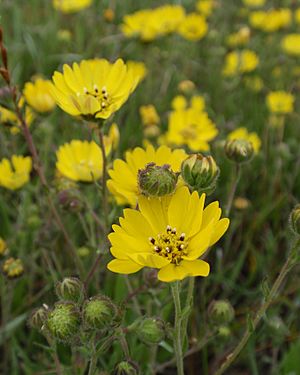Coast tarweed facts for kids
Quick facts for kids Coast tarweed |
|
|---|---|
 |
|
| Scientific classification | |
| Kingdom: | |
| (unranked): | |
| (unranked): | |
| (unranked): | |
| Order: | |
| Family: | |
| Genus: |
Madia
|
| Species: |
M. sativa
|
| Binomial name | |
| Madia sativa Molina, 1782
|
|
Madia sativa, often called coast tarweed or Chilean tarweed, is a type of flowering plant. It is part of the aster family. You can find this plant in parts of western North and South America.
Where Does Madia sativa Grow?
Madia sativa is originally from the Americas. It grows in two main areas:
- The west coast of North America. This includes Alaska, British Columbia, and all the western mountain ranges of California. It stretches down to Baja California.
- South America, in countries like Chile and Argentina.
This plant can grow in many different places, even in areas that have been changed by people. In western North America, it is most common in coastal grasslands and nearby areas.
What Does Madia sativa Look Like?
Madia sativa is an annual herb. This means it lives for only one growing season. It can be small, about 20 centimeters (8 inches) tall. But it can also grow very tall, over two meters (about 6.5 feet)!
Its stem has many leaves and can have branches. The plant feels very sticky because it is covered in special glands that produce resin. It also has a strong smell. The leaves are long and narrow, or shaped like a spear. The lowest leaves can be up to 18 centimeters (7 inches) long.
The plant's flowers usually grow in a cluster of flower heads. These heads are surrounded by bristly, sticky leaves called phyllaries. Each flower head has about 8 yellowish ray florets. These are like the petals you see on a daisy. They are only a few millimeters long. In the center are several disc florets, which have dark anthers at their tips.
The fruit of the plant is a flat, smooth achene. It does not have a pappus, which is a fluffy part that helps some seeds fly in the wind. People have grown this plant to get oil from its seeds.
See also
 In Spanish: Melosa para niños
In Spanish: Melosa para niños

